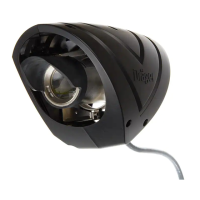The Handheld Terminal
32
The Handheld Terminal
Description
The Draeger PLMS Handheld Terminal is a robust and weatherproof unit, certified for use in the Hazardous Area. It replaces the
MTL611B Communicator (based on a Psion Organiser) that was formerly supplied. The Terminal is used to align and zero the
Dräger Polytron Pulsar 2 Transmitter and Receiver and to provide basic configuration and diagnostic functions. Comprehensive configu-
ration and diagnostics are also provided in conjunction with a personal computer located in the Non-hazardous Area. Thus a new config-
uration file can be loaded into an internal memory from the PC, and then copied into one or more Dräger Polytron Pulsar 2s located in the
Hazardous Area. Similarly, the unit can store the internal data-logger records of up to three Dräger Polytron Pulsar 2s, and then transfer
the files to the PC for analysis or transmission.
An adaptor cable (optional) also allows the Terminal to be connected to the AI500 Digital Interface, through a port separate from the EIA
RS 422/485 that may be hard-wired into a system. It can be used to configure the tag identification string and multi-drop node address of
the AI500, and also to link through the AI500 to any of the four Dräger Polytron Pulsar 2 Receivers connected to it. In this way the Termi-
nal provides all the same functions that it would do if connected directly to the remote Receiver in its possibly inaccessible location.
Battery
The Intrinsic Safety certification requires that only the specified battery type is used and that it be replaced in the Non-hazardous Area. To
gain access to the battery compartment, undo the four captive screws with a Philips screwdriver and remove the transparent cover, noting
that the cover is keyed for the correct orientation. With a 2mm hexagon key loosen (but do not remove) the four socket head screws that
retain the metal battery cover. Slide the cover outwards until it clears the heads of the screws and remove it. Attach the battery connector,
slide the battery into the space provided, replace the covers as they were and tighten the screws. Take care to orient the transparent
cover in the correct keyed position or the waterproofing gasket will not be properly compressed.
Note that battery life is reduced at low temperatures. However, the unit switches off automatically whenever no key is pressed for five min-
utes, so the life is greatly extended in the normal circumstance that the Terminal is used intermittently. To conserve the battery it should be
removed when the unit is not in use or could be switched on accidentally, for instance in transit.
Operation
Switch the Terminal on by pressing one of the four keys. It can be left to switch off automatically, or be switched off manually by pressing
any two keys at the same time. It connects to the Dräger Polytron Pulsar 2 Transmitter (Tx) or Receiver (Rx) through their Intrinsically Safe
ports. Unscrew the knurled metal cover and screw in the metal connector of the Terminal's integral flying lead. Remember always to
replace the waterproof covers to prevent corrosion. The separate mating connector (marked 'Comms Port') mounted on the body of the
Terminal is for connection to the PC and also provides a convenient sealed receptacle for the flying lead when not in use.
As soon as the Terminal is attached to an operating unit (Tx, Rx or AI500) it initiates a two-way dialogue to determine the connection. The
screen displays the serial number and tag string of the local unit, together with the current measured data being output from the Receiver.
In most systems the data will be available at the Transmitter as well, relayed via the digital link through which the Receiver also controls
the Transmitter's flash rate. The data will similarly be available at the AI500, but only after you have chosen which of the four input streams
is to be displayed.
Pressing any of the keys switches the display to a series of menus. Each menu offers four choices, corresponding to the four keys. To
keep the menu structure simple and intuitive, you are presented with just those menus that are appropriate to the connection that has
been determined (Tx, Rx, AI500 or none). Be aware, however, of two circumstances in which the automatic connection process needs
your intervention. The first is when the Terminal is moved rapidly from one Dräger Polytron Pulsar 2 head to another. It detects a possible
new connection when there is a gap in the data stream exceeding 30 seconds. If you move to a new unit quickly enough to fool it then
select the menu item to identify the new connection. Secondly, when the Receiver switches the Transmitter into its Strong Mode
(because gas has been detected or the beam path is attenuated) the rapid stream of data from the Receiver takes precedence over the
dialogue between the Transmitter and the Terminal. Simply place a hand in front of the lens for a few seconds to break the stream and
allow the dialogue to take place.
The menus are designed to be intuitive and self-explanatory. Much the best way to familiarise yourself with them is by using the Terminal.
The following summaries are intended only to give you an overview of what to expect.
WARNING
The Dräger Polytron Pulsar 2 has no user-serviceable parts. Unauthorised opening can lead to a safety-
related failure of the unit. Any unauthorised opening of the unit invalidates all guarantee claims.
NEW

